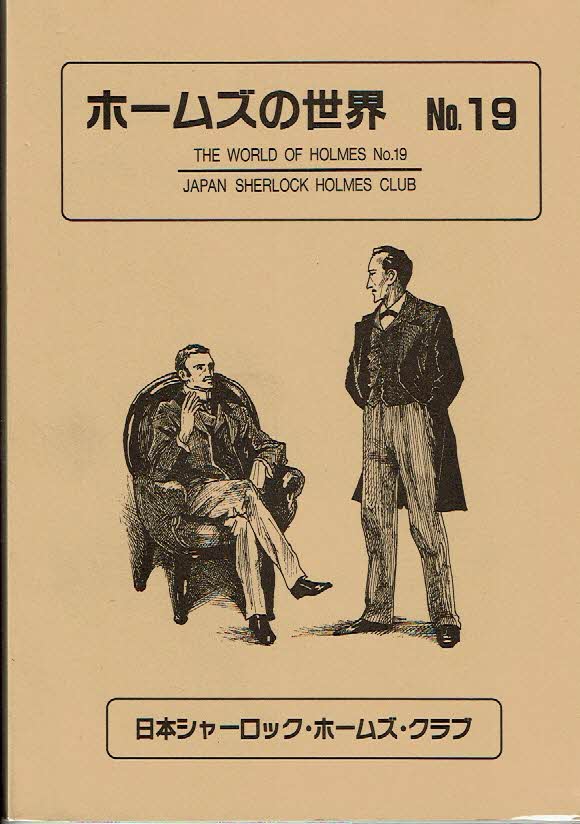The World of Holmes No.19

ホームズの世界
The World of Holmes No.19

| Sasano, Fumitaka “Literary Origin of “A Case of Identity” Part 3” | 笹野史隆「花婿失踪事件 の文学的祖先(その3)」 | WH No.19 (1996),1-13p |
| The author lists up literary works that may be the origin of the episodes in IDEN from eight points of view. The works referred to as the origin are those by Edgar Alan Poe, E. Hoffman, Charles Dickens, Honor? de Balzac, Maupassant, Alexandre Dumas, Robert Stevenson and a few other writers. | ||
| 以下の10項目に分け、他の文学作品との類似性やヒントとなった可能性などを論じる。具体的には、1)窓からの推理。ポオ(群衆の人)、ホフマン(隅の窓)。2)外見からの推理。ディケンズ(荒涼館)(モンマス街での瞑想)、バルザック(従兄ポンス)(浮かれ女盛衰記)(ゴプセック)(優雅な生活論)。3)呼び鈴の鳴らし方。バルザック(従妹ベット)、モーパッサン(遺産)、デュマ(ノートルダムの居酒屋)、ディケンズ(大いなる遺産)。4)利益を得る者は誰か。この言葉について、モリス・ローザンブラムは、古代ローマの政治家・哲学者のキケロからきていると指摘。ポオ(お前が犯人だ)、デュマ(モンテ・クリスト伯)、スティーヴンスン(二つの薔薇)。5)馬車からの脱出。ガボリオ(ルコック探偵)。6)偽りの恋。オウィデウス(転身譜)。7)義歯と妻。バルザック(夫婦の生態)。8)手紙を書いたことを推理する。ボーマルシュ(セヴィラの理髪師)、バルザック(十三人組)。9)結婚式当日の破談。ディケンズ(大いなる遺産)。10)犯人を部屋におびき寄せて、ドアに鍵をかける。ポオ(モルグ街の殺人)、ディケンズ(荒涼館)、ファーガス・ヒューム(二輪馬車の秘密)。 | ||
| IDEN | ||
| Ishii, Takashi “A Study of “The Seven-per-cent Solution”” | 石井貴志「SHの素敵な挑戦 の研究」 | WH, 19(1996), 14-23 |
| A study about the film “The Seven-Per-cent Solution”. The author discusses the background, the contents and the evaluation of the film, and also the originality of the story of the film. | ||
| 映画「SHの素敵な挑戦」についての分析と研究。米国と日本での評価。新聞広告やスチール写真なども掲載。原作と映画の違いや、ホームズとフロイトとの関係。更に、批評家が嵌まった罠について検証する。 | ||
| TV Dramas & Movies | ||
| Satake,Tsuyoshi “The Three Smiths” | 佐竹剛「三人スミス」 | WH No.19 (1996),24-26p |
| The author put a focus on the people with the name “Smith” in the Canon and suggests the relationships of the Smiths in different stories, | ||
| 三人のスミスという姓の人物についての仮説と検証。バイオレット・スミス、ウイロビー・スミス、カルヴァートン・スミスの複雑な関係性について、年代学から「瀕死の探偵」「金縁の鼻眼鏡」「自転車乗り」と続く事件の流れについて考察する。 | ||
| SOLI GOLD DYIN | ||
| Kumagai, Akira “The Rhetoric of “The Hound of the Baskervilles”” | 熊谷彰「バスカヴィル家の犬 の空白域」 | WH No.19 (1996),27-41p |
| The author looks at the reason Holmes disappeared in the halfway of the story in HOUN. He analyses how Holmes and the criminal met in all the short stories. He concludes Doyle’s way of writing fits to short stories and that Holmes’s disappearance in the middle of the story in HOUN is to spin the story to a long one. | ||
| 「バスカヴィル家の犬」で、ホームズが中盤に物語から表面上姿を消すこと(空白域)について考察。著者は全ての物語で、ホームズと犯人の出会い方を詳しく分析。ドイルの執筆方法が、間延びしない捜査 → 事件解決 → 手短な原因説明、の短編手法と推理。故に、長編では短編要素を引き延ばしたと考察。従って「バスカヴィル家の犬」の空白域に注目すると、ホームズは本質的には短編の主人公である、と結論。 | ||
| HOUN | ||
.
| Hiraga, Saburo “Two Towns in Dartmoor” | 平賀三郎「ダートムーアの二つの町」 | WH No.19 (1996),48-56p |
| The author examines the places the cases of HOUN and SILV occurred and concludes both cases happened in Tavistock in Dartmoor. | ||
| ダートムーア国立公園を舞台とした「バスカヴィル家の犬」「白銀号事件」のモデルとなった町について考察。聖典内の記述と当時の鉄道網、研究書などから推理。タビストックが該当すると結論。 | ||
| HOUN SILV | ||
| Takakura, Nozomi “Sherlock Holmes as a Violinist” | 高倉希「ヴァイオリン奏者としてのシャーロック・ホームズ」 | WH No.19 (1996),61-63p |
| The author looks at Sherlock Holmes’s level as a violinist and sees he would be far from a professional violinist though he was a good player as an amateur. | ||
| ホームズのヴァイオリン演奏、実際の実力について考察。著者の経験から、幼少期からの練習量がプロとアマチュアの差であると指摘。ホームズが幼少期から習っていた可能性を、自身の経験から演奏の技術を検証し、ワトスンに聞かせた曲が手慣れた曲ばかりだった為、上手だと思わせてしまったと推測。ホームズのヴァイオリンの演奏技術は、アマチュアレヴェルだと結論。 | ||
| Music Limits of Knowledge (Including Methods) |
||
| Ietsugu, Fusao “Sidney Paget” | 家次房夫「シドニー・パジット」 | WH No.19 (1996),64-86p |
| A study on Sidney Paget. The author lists up Paget’s works as an illustrator of the Canon and its evaluations by noted Sherlockians. A brief chronology of the lives of Sidney Paget and his brother Walter and comments on some of his illustrations are also included. | ||
| シドニー・パジットがホームズ物語に描いた挿絵について考察。年代毎の作品との表と、イラスト絵について個々に詳しい解説。パジットと、ドイルや出版社とのやり取りなども検証。また、パジット以外の挿絵画家についても詳しく検証する。 | ||
| Art | ||
| Kitahara, Naohiko “The Casebook of “Detective Hoshina”” | 北原尚彦「ホシナ大探偵 事件簿」 | WH No.19 (1996),88-93p |
| The author introduces the story “Detective Hoshina” by Oshikawa, Shunro, a science fiction pioneer in Japan. The work is considered as an adaption of the Canon and has long been searched and finally found by Yokota, Jun’ya, a Japanese SF writer/researcher. The story is revealed to be an adaption of LADY. | ||
| 幻のホームズ物の翻案、押川春浪の(瞼奇探偵小説・ホシナ大探偵)の研究。著者の豊富な知識から、小説家・押川春浪の経歴や同時代のホームズ物翻案を列記。更に(ホシナ大探偵)が、収録作三編の内の一つだったことを発見。記述内容の検証から、「レディ・フランシス・カーファックスの失踪」の翻案であることを突き止める。 | ||
| LADY Japan Translating and Interpreting | ||
| Endo, Takahiko “Sherlockians, Let’s Go See “The Cats”” | 遠藤尚彦「What is Macavity? シャーロッキアンはCATSを観に行こう!」 | WH No.19 (1996),95-102p |
| The author introduces T.S. Eliot’s poems “Macavity the Mystery Cat”, and the character of Macavity is a literary allusion to Professor Moriarty. He suggests it would be more fun to read Eliot’s poems to see the musical “The Cats”, which is originated from the poems. | ||
| T.S.エリオット原作のCATSについて。元となった1939年発表の詩集(ポッサムじいさんの猫行状記)から、主人公と聖典との関係を指摘しつつ、過去の研究と研究者に対しての敬意を持つべき、と提言する。 |
||
| Stages | ||